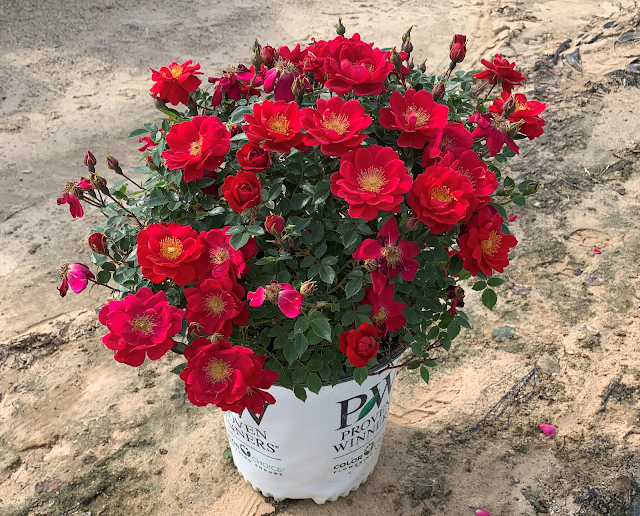If you subscribe to this blog than you now Dale and I visited with Chris Warner the Oso Easy rose breeder while in England. Getting to his Shropshire home was not easy even with a GPS unit. English addresses are a tad bit strange and the GPS does not like them. Thank goodness for cell phones!
 |
| Chris Warner in his rose breeding greenhouse |
It was a great pleasure to visit with Chris and the get a better feel for how he breeds and selects his roses. For example - he leaves any diseased seedlings in his greenhouse seed beds so there is plenty of fungal inoculum available to infect and show which seedlings have the greatest disease resistance. We got to see all phases of his testing and selection. It is in the later stages in the process where Chris gets ruthless about culling out any diseased seedlings. Still even at these stages there are old rose plants near by to infect any susceptible roses.
One of Chris's most disease resistant roses in the Oso Easy line is a bright and cheerful red rose with a yellow center called Urban Legend. This rose is so healthy and floriferous it has been awarded the Lord Burleigh Award for Best Disease Resistant Rose, the Chauncey Beadle Award for Best Shrub Rose at the 2018 Biltmore International Rose Trials at the Biltmore Estate in Asheville, N.C. and the American Rose Society Award of Excellence. Now I have to be totally honest with you when it come to this rose. When it was time to name this rose, we considered several other names, including Barbed Wire, Brinks and ADT. These names may seen a bit strange, but you have to understand this is a very thorny rose, and because so it is perfect for planting under windows in high crime areas. There is a real need for security plants and the names were our attempt to position this rose for that very purpose. We settled on Urban Legend which speaks to it usefulness in fighting crime but also to its award winning disease resistance and flower power.
 |
| A container shot of this roes sent to us by a customer in Texas |
 |
| Urban Legend on the left and nock out on the right in out test garden. |
Chris has also made a name for himself with his hybrid Hulthemia Persica rose breeding sold under the series name Ringo Roses. Ringo Yellow is a magically colored rose with yellow, red pink and white in the bloom. His Ringo roses are substantially hardier and more disease resistant than anything else in the catagory. Ringo has proven it self by winning awards at the Hauge Rose Trials, first place at the Lyon Rose Trials and Gold at the Gold Standard Rose trials.
 |
| The original Ringo Rose from Chris Warner |
 |
| Ringo is sold under the Proven Winners brand in the USA |
Ringo® Double Pink (Rosa 'Chewdelight), also a Hague Rose Trial First Class Certificate winner, comes with a fuchsia pink flowers, a dark magenta center and having 15 to 25 petals. It too has been a worldwide hit with rose growers.
 |
| Ringo Double Pink did excellent in our container rose trial |
It is always a pleasure to spend time taking plants with a plant breeder, but it is even more so with Chris. He has such a depth of knowledge and such great enthusiasm for roses and it is evident in his plant introductions. They are smart and elegant. Beautiful, yet useful. Healthy, yet happy. I cannot wait to return to Shropshire, England!















 I’ve visited Szczepan in Poland a few years ago and fortunately for me the Lonicera vines were in full bloom. Oh how I love fragrant plants.
I’ve visited Szczepan in Poland a few years ago and fortunately for me the Lonicera vines were in full bloom. Oh how I love fragrant plants.


